Recommended Varieties/Cultivars
GardenZeus recommendations in this section are grouped by species for the most commonly grown pumpkins in California and the United States: Cucurbita pepo, Cucurbita maxima, and Cucurbita moschata.
For an explanation of pumpkin types by species, see Getting to Know Garden Pumpkins: A GardenZeus Guide to Types, Species, and Characteristics.
Growing your own pumpkins allows you to enjoy many interesting, unusual, novelty, and delicious varieties that may be difficult or impossible to find in supermarkets or even farmers markets. Some of the best varieties are listed below.
Cucurbita moschata varieties are generally more heat-tolerant and often perform better than C. pepo or C. maxima during hot summers. GardenZeus recommends
Musquee de Provence (120 days), a moschata, heirloom that is somewhat heat tolerant, as perhaps the best overall pumpkin variety. It produces large, beautiful, widely and deeply ribbed, flat pumpkins of 5 to 20 pounds that can be carved but are ideal for soups, pies, and other cooking. Pumpkins are primarily orange but have shades of green, brown, and yellow, and they store well for several months. Musquee de Provence fruits are a dream of autumn and Thanksgiving captured in vegetable form. Also consider Long Island Cheese (100 days), which produces large, ribbed fruits that may be used as pumpkins; seeds may be sold as squash.
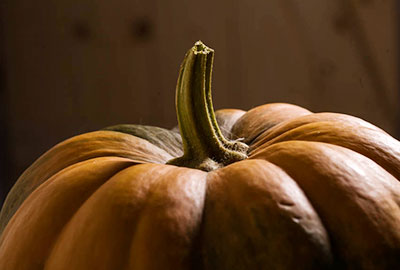
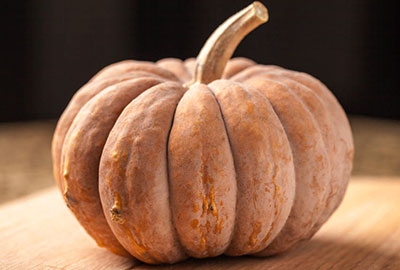
- Jack-O'-Lantern (105 days) is a classic carving pumpkin, producing fruits of about 7 to 14 inches tall that may weigh up to 20 pounds. It stores well as compared to other pepos, and may be the best carving variety for growing and harvesting early to avoid late-summer heat iwhile still being fresh enough for carving in October.
- Howden (110 days) is another classic decorative autumn and Halloween variety.
- Sugar Pie (100 days) produces 4-to-6-inch pumpkins, and is a longtime favorite for cooking and baking. It's also ideal for decorative pumpkins or jack-o'-lanterns in small areas or inside your home.
- Batwing is a novelty hybrid pepo that can mature in just 90 days. It produces small pumpkins of up to 5 inches across with varying green lower portions of young fruits for a "dipped" look, and with fruits maturing to orange.
- Jack Be Little (95 days) is a miniature, wider-than-tall and ribbed pepo variety, producing decorative fruits of about 3 to 4 inches wide and 2 inches tall. It's also suitable for cooking, but the small size of fruits may limit options and portions. It stores well for several months under ideal conditions and when cured properly.
- Little October (95 days) produces round mini pumpkins of about 3 inches wide for painting, crafts, decoration, or mini jack-o'-lanterns.
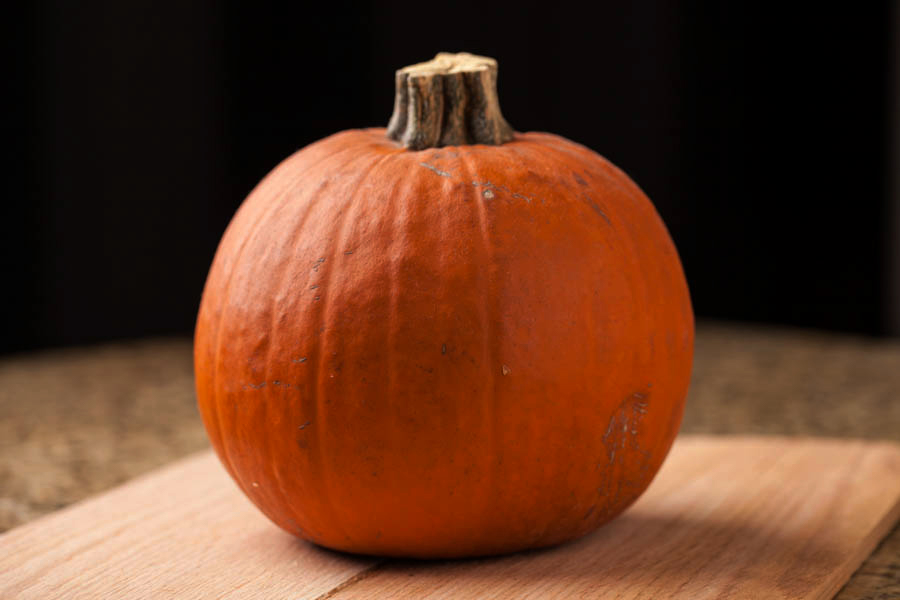
- Atlantic Giant (120 days) is the maxima variety that has won giant-pumpkin awards and regularly set new world records since the late 1970s. Big Max (120 days) reliably produces pumpkins in the range of 40 to 70 pounds, and in the right growing conditions can easily double or triple that weight.
- French Cinderella or Rouge Vif e’Etampes heirloom (110 days) produces classic wider-than-tall ribbed pumpkins that have provided inspiration for many an animated fairytale or fantasy artwork. Fruits may grow to 18 inches or more wide and 8 to 25 pounds, and store well for months.
- For color options other than orange, try Jarrahdale (100 days) an heirloom maxima that produces ribbed, blue-grey fruits in the range of about 3 to 12 pounds, and is excellent for baking after being used for decoration.
- Lumina (90 days) is an unusual white-skinned variety, yielding fruits of about 5 to 15 pounds that are ideal for carving, painting, and Halloween fun. Flavorful orange flesh is also well-suited to cooking and baking.
- Red Warty Thing (110 days) is an eye-catching, conversation-starting, flavorful heirloom that produces fruits ranging from about 8 to 20 pounds with vibrant red-orange skin that is covered in bumps. Fruits store well for months when cured properly.
- Porcelain Doll is a hybrid maxima that produces pink ribbed fruits of about 12 - 25 pounds. Plants are moderately resistant to powdery mildew and fruits are good for cooking and baking. A portion of proceeds from seed sales goes toward battling breast cancer.
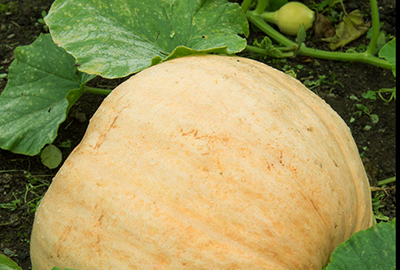
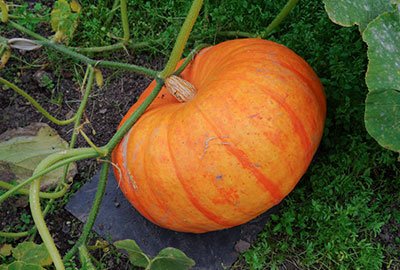
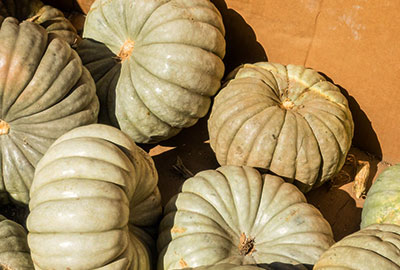
Buying/Selection Tips
Purchase seeds, not seedlings. Pumpkins should generally be seeded directly outdoors. GardenZeus recommends against purchasing pumpkin starts for transplant, especially if rootbound or it has been more than about 2 weeks since germination, as starts may be prone to slow establishment, poor yield, diseases, pests, and other problems.
If you see small flowers on pumpkin starts, do not purchase or plant them. They have already entered their reproductive cycle; this is a condition called "early senescence." If a pumpkin seedling produces flower(s) while at a small size, it may never reach full size and may produce little or no yield.
For tips and information about purchasing vegetable seedlings, see : The GardenZeus Guide to Buying Vegetable Seedlings.
Soil Needs/Tip
Pumpkins are heavy feeders that benefit from well-drained, loose, fertile soil with sufficient calcium and moderate-to-high organic matter. Avoid growing any squash or pumpkin varieties in the same place for more than one season at a time to avoid depleting soil and concentrating pest populations and diseases.
See GardenZeus Alert: Beware of Heavy Feeders! for precautions about successive planting of vegetables that may deplete your soil.
As long as fertility and drainage are sufficient, most pumpkin varieties perform well in a variety of soils. Pumpkins are less fussy than some vegetables about soil acidity, and perform reasonably well in the range of about 5.8 to 6.9 pH.
Pumpkins often grow slowly, produce little yield, become chlorotic, and may be prone to pests and diseases if planted in new, uncultivated, infertile, or compacted soils.
Suitable Microclimate
Pumpkins need full sun and sufficient space in fertile soil that is consistently moist but not wet. They do well in raised beds with southern and western exposures.
Ideal temperature range for germination is 70° to 95°F with fastest germination at the warmer end of this range. Ideal temperature range for growth and fruiting is about 65° to 75°F. Most pumpkin varieties withstand temperatures up to 100°F, but growth and fruiting may be diminished at temperatures above 85°F, and flowers may drop at high temperatures. Most varieties grow slowly or not at all at temperatures below 60°F.
Pumpkins will benefit from shade during hot summer afternoons. See GardenZeus Tips for Shading Vegetables During Hot Weather for creative ideas from expert Darren Butler about providing shade.
Getting Started
If you've never grown pumpkins, consider starting instead with zucchini or summer squash that mature quickly and yield abundantly, often before insect pests and diseases can take much of a toll. Pumpkins have high nutrient needs, generally need a long growing season, and require more attention than summer squash, such as for curing after harvest. The long growing season required for pumpkins means they're more prone than summer squash to succumb to pests, diseases, heat stress, or other garden problems before fruits mature.
It's important to pay special attention to growth habit and plant size when planning a pumpkin patch or bed. For some varieties under ideal conditions, a single pumpkin seed may grow into a behemoth covering 200 square feet. Most pumpkin varieties produce vines that spread to several feet or more, and require large spaces. They may overwhelm other nearby plants. Bush, semi-bush, and smaller varieties are also available. See "Container Gardening" in the GardenZeus section "Planting and Maintaining" for compact and small-space varieties.
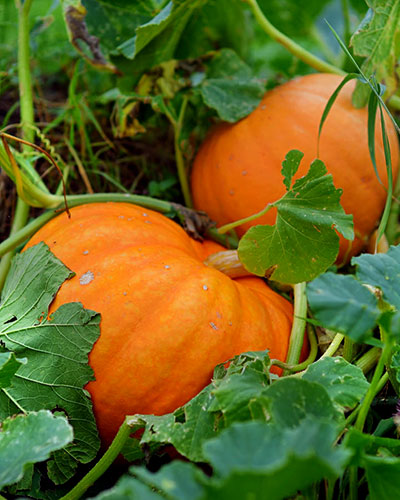
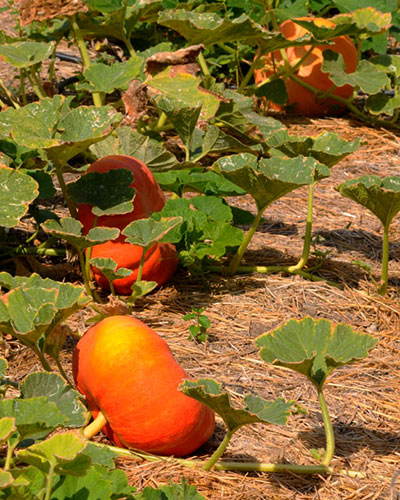
Growing pumpkins can be challenging in hot-summer California areas. It can be especially tricky to time planting and cultivation of garden pumpkins such that despite the heat of summer and early fall, your homegrown pumpkins are ready for harvest or still fresh enough for carving or eating by Halloween and Thanksgiving.
See
Timing for Growing Halloween Pumpkins in Hot-Summer California Areas for tips and timing strategies to succeed with growing Halloween and Thanksgiving pumpkins.
Most pumpkin varieties, including mini pumpkins, produce a few to several fruits total per plant. For large and giant varieties, each plant may yield only 1 to 3 fruits, or fruits may be thinned to 1 or 2 per plant for optimal size and quality. This allows for simple math to determine how many pumpkins plants you need. If you are new to growing pumpkins and/or don't have fertile, living soil, expect about 30% to 50% loss in harvest for attrition and low productivity. For most varieties this comes out to about 3 to 5 plants for every 8 to 10 harvested pumpkins, and about 1 plant for every 1 or 2 harvested giant pumpkins.
Watering Tips
Pumpkins benefit from consistent soil moisture and are prone to diseases in wet soils or if overwatered. Seeds may rot if kept overly wet when germinating. Avoid watering with sprinklers. Leaves of pumpkin plants should be kept entirely dry as much as possible.
See The GardenZeus Guide to Watering Cucumbers, Melons, and Squash (Cucurbits) for tips and more information about watering pumpkins.
Planting Method/Tips
Plant pre-germinated seeds (not transplants) or seed pumpkins directly outdoors when frost risk is low and daytime temperatures are consistently 65°F and above.
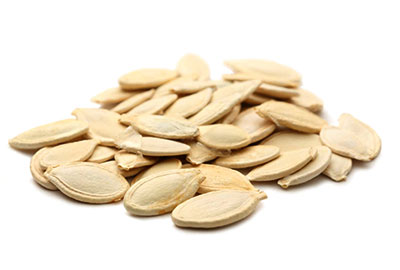
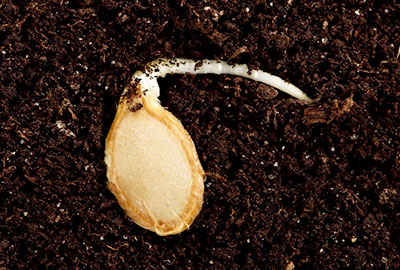
See Growing Winter Squash and Pumpkins in the California Home Garden for detailed information about growing pumpkins.
Spacing
Pumpkin spacing depends upon variety, planting style, and available garden space. Pumpkins are traditionally planted with 2 to 4 seeds per planting hole or mound, then thinned to one plant per hole, spaced about 3 to 5 feet apart for compact and bush varieties; and 6 to 10 feet or more apart for larger vining varieties. Plant seeds about 1 inch deep.
When grown in rows, plant bush varieties about 8 to 12 inches apart in rows 3 to 5 feet apart. Thin plants to one every 3 to 5 feet, depending upon variety. Vining varieties can be seeded about 1 to 2 feet apart, with final spacing of about 4 to 10 feet or more apart in rows that are about 6 to 15 feet apart, depending on variety. Many pumpkin varieties need 100 square feet or more per plant for optimal growth and yield. Spacing pumpkins too closely may result in reduced yield from smaller and/or fewer fruits.
Timelines
3 to 10 days or longer to seed germination. Generally, pumpkins should germinate within a week if kept moist at temperatures of 70° to 95°F.
Transplanting is possible about 10 to 18 days after germination but recommended only for skilled biointensive gardeners and experienced gardeners who are willing to monitor seedlings closely.
10 to 21 days after germination to 1st thinning.
Thin to final spacing by about 3 to 4 weeks after germination, possibly longer during cool weather or for slow-growing plants.
About 85 to 130 days, sometimes longer, from germination to harvest of pumpkin fruits, depending on variety and growing conditions.
Harvest Period: Most pumpkins varieties produce a-few-to-several fruits (1 to 3 fruits for giant varieties) that are usually harvested at full maturity, often during a harvest period of days or weeks at the end of the growing season.
Pollination Needs/Tips
Adequate pollination is critical for most pumpkin varieties to produce fruits. Lack of pollination is the most common reason for female pumpkin flowers dropping off a plant or failing to produce fruit.
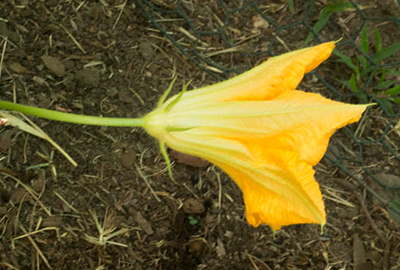
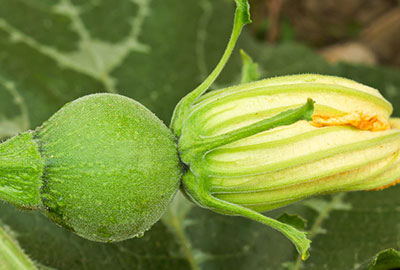
See Pollination Problems and Solutions for Cucumbers, Melons, and Squash (Cucurbits) for tips and information about pumpkin pollination.
See Saving Pumpkin Seeds: It's Complicated for more information about saving seeds from homegrown or purchased pumpkins.
Interplanting/Companion Planting
Because lack of pollination is a primary reason for poor yield, GardenZeus recommends encouraging bees to visit your pumpkins by planting borage, nasturtiums, rosemary, oregano, and other bee-attracting herbs and plants nearby. Allowing vegetables like radishes and carrots to flower and persist in your garden while pumpkins are in bloom may also attract bees and help with squash pollination.
Avoid planting root crops, such as beets, onions, and potatoes, near pumpkins, which may disturb sensitive pumpkin roots when harvested.
The main concern with companion planting for pumpkins is that with the vigorous growth, long vines, and sprawling habit of many varieties, pumpkin plants may simply overwhelm, cover, and starve other plants by blocking sunlight. Vining pumpkins are generally not recommended for interplanting. Pumpkins can be successfully grown with tall or large columnar plants, such as sunflowers, amaranth, and giant corn.
The Three Sisters is a traditional Native American agricultural grouping that includes corn, beans, and squash. Will this combination work with pumpkins in your garden?
See GardenZeus Quick Tips: 'The Three Sisters' Companion Planting Combination for California
Nutrient/Amendment/Fertilization Needs/Tips
Pumpkins are heavy feeders. A soil test is recommended to determine nutrient levels prior to applying fertilizer.
Work compost, composted manures, or well-rotted organic matter into soils before planting, and maintain nutrient-rich surface dressings under mulch. Bury plugs of finished compost or worm compost a few inches outside of the driplines of established pumpkin plants 2 or 3 times per growing season and water thoroughly. For soils low in calcium, crush or grind up eggshells and add to the soil surface under mulch at the base of each plant. Grow pumpkins or other cucurbits only once every 2 to 4 years in a given bed or garden area to allow the soil to recover between plantings.
GardenZeus recommends adding nitrogen in the form of diluted urea or a cup of chicken manure diluted in 4 gallons of water (half cup if fresh manure) and mixed thoroughly, after seedlings are a few to several inches tall and about once or twice per month thereafter. Adding too much nitrogen may result in rapid growth and lush, high-carbohydrate leaves that attract insect infestation; and slowed or reduced yields.
In hot-summer areas, reduce or discontinue fertilizing with nitrogen by late spring or early summer to avoid producing large, lush leaves that will tend to wilt and cause stress to squash plants during summer heat.
Fish emulsion or seaweed extracts applied as drenches or foliar spray may be beneficial in soils that are infertile, alkaline, or lacking micronutrients.
Mulching
Mulching pumpkin plants is particularly important, especially during warm-to-hot weather, to maintain even soil moisture, cool soils during hot weather, and inhibit weeds to avoid root disturbance from weeding. Use a half-inch of fine mulch for small starts under 4 inches in height; increase to 1 to 2 inches or more of fine to medium mulch after plants are 6 to 12 inches tall.
Straw and/or pine needles make good mulches for pumpkins. Having plenty of mulch around pumpkins is a benefit when plants begin fruiting; mulch can be mounded here and there as necessary to support pumpkin fruits and prevent them from resting on damp soil, which encourages prematurely rotted fruit.
Pruning/Cutting Back/Pinching/Separating
Pumpkin plants may be pruned and/or flowers and fruits thinned for many specific reasons, including improving size and quality for giant pumpkins, or for intensive growing such as in a greenhouse, small growing space, or container. For most gardeners growing pumpkins outdoors, there is no need to prune plants, and doing so may encourage pests or diseases and reduce yield.
Pinch off or remove early flowers from young pumpkin plants to encourage vegetative growth, for a more vigorous and larger plant before it begins putting energy into fruiting, which may increase overall yield.
Remove all flowers and small fruits that appear late in the growing season to optimize size and quality of existing fruits before harvest.
If you are trying to grow large fruits or a giant pumpkin, remove all new flowers and all smaller fruits after selecting the primary fruit(s) that will be grown to maturity.
GardenZeus generally does not recommend cutting back or removing pumpkin leaves or stems. One exception is judicious thinning of leaves if plants wilt persistently during hot weather despite having ample soil water.
For more information see The GardenZeus Guide to Watering Cucumbers, Melons, and Squash (Cucurbits)
Propagating
From seed. GardenZeus recommends open-pollinated, untreated, organically grown seeds.
Container Gardening
Because of plant size and needs for soil volume, most pumpkin varieties that produce full-sized fruits are not well-suited to growing in containers.
Bush, semi-vining/semi-bush, small, and miniature pumpkin varieties may produce good yields in well-drained containers that are at least 18 inches wide and deep. Ideally, even miniature pumpkin varieties should be planted into trash-can-size-or-larger containers filled with fertile, living soil. A trellis or structure for climbing may help vining pumpkins to remain manageable, receive enough sunlight, and yield well when grown in containers.
Jack Be Little (95 days) is a miniature, wider-than-tall, ribbed variety that GardenZeus expert Darren Butler considers the overall best pumpkin variety for containers. It produces decorative fruits of about 3 to 4 inches wide and 2 inches tall. Plants are compact with short vines of about 3 to 5 feet, and produce about 4 to 10 fruits per plant. Little October (95 days) produces round mini pumpkins of about 3 inches wide for painting, crafts, decoration, or mini jack-o'-lanterns. Batwing (90 days) is a novelty, semi-bush hybrid. It produces small pumpkins that are about 3 to 5 inches wide with variable lower portions of young fruits in green for a "dipped" look, and with fruits maturing to orange. For more details about these varietes, see "Recommended Varieties/Cultivars" in the GardenZeus section "Getting Started."
Plant 2 to 3 pumpkin seeds per large container and thin to 1 plant when seedlings are 2 to 5 inches tall. Soil tends to dry out more frequently in containers or raised beds, so be sure to monitor as needed and provide sufficient and consistent water.
See GardenZeus Tips for Container Vegetable Gardening for general information and tips about growing vegetables and herbs in containers.
Seasonal Care
Pumpkins are a warm-season crop because they are frost sensitive, but they also suffer in heat. They grow and fruit best at temperatures from 60° to 85°F, with optimal growing temperature between 65° and 75°F.
Seed pumpkins or plant pre-germinated seeds directly outdoors in late winter or spring when frost risk is low and daytime temperatures are consistently 65°F and above. Planting early is important in many California areas to allow for the long growing season required for most pumpkin varieties before hot weather stresses plants and reduces yields. Starting seedlings early, while temperatures are still cool to cold, increases risk of damage or loss of plants to frost during cold years and in colder areas of California, but also generally minimizes problems from insect pests, which can be so intense during warmer weather that it can be difficult to establish seedlings.
It can be especially tricky to time planting and cultivation of garden pumpkins in hot-summer areas such that despite the heat of summer and early fall, your homegrown pumpkins are ready for harvest or still fresh enough for carving or eating by Halloween and Thanksgiving.
See
Timing for Growing Halloween Pumpkins in Hot-Summer California Areas for tips and timing strategies to succeed with growing Halloween and Thanksgiving pumpkins.
Use row covers, or improvised materials such as cloth sheets or cardboard, overnight to protect plants from late frosts. Remove covers during the day for sunlight and to allow pollination by insects.
Pumpkins will benefit from shade during hot summer afternoons. See GardenZeus Tips for Shading Vegetables During Hot Weather for creative ideas from expert Darren Butler about providing shade.
Pumpkins may also be grown in mild-winter California areas beginning late summer or fall. This is a less-certain planting window than late winter or spring, as young seedlings may become stressed or die quickly in dry soils during late heatwaves, and plants may need protection from occasional late-fall or winter frosts. Plants may grow and produce slowly or not at all during cool-to-cold weather. Plant pre-germinated seeds or seed directly outdoors during cool periods beginning late summer or fall.
As pumpkin plants mature, they may be infested by leafminers and other insects. Leaves may be covered in mildew, chlorotic, or bug-eaten. Plants often continue to produce mature fruits and produce a yield despite looking ragged and unhealthy.
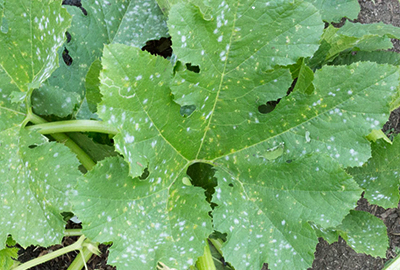
How to Harvest
Pumpkins are often left unharvested until the end of a long growing season when plants have died back. Different varieties may have unique clues or signs that fruits are mature. Most varieties are ready for harvest when fruits are in full color, rinds are firm, and the nearby vines and stem to a fruit have shriveled or died. Plant leaves and stems may generally be turning brown and dying.
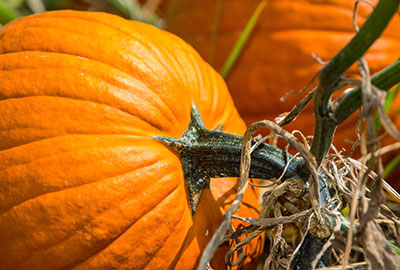
Be patient and wait until full maturity to harvest pumpkins. Fruits will not continue to mature or harden if harvested early, and immature fruits will not last well in storage.
Use a knife or pruning shears to cut pumpkins from the vine. Loppers or a pruning saw may be needed for large fruits or thick stems. Leave 3 to 6 inches of stem above the fruit, and avoid using the stem stub as a handle for lifting or moving a pumpkin. A sufficient stem stub slows and reduces microbial infection coming in through the stem and will result in a longer storage period for the pumpkin.
Many pumpkin varieties are cured after harvesting. Curing reduces water in pumpkin fruits and hardens their skins, preparing them to last as long as possible in storage. Curing also tends to increase sweetness of pumpkins because it reduces their water content in proportion to sugars. Pumpkin fruits are ideally cured unwashed outdoors in sunlight at warm temperatures (ideally about 80° to 85°F) for about 7 to 14 days. Fruits should be kept dry while curing, and may need part shade to avoid sunscald, particularly during warm-to-hot weather. They can be cured indoors in a well-ventilated area if weather is cool or rainy, or if curing fruits may be subject to wet soil, sprinklers, or other irrigation.
Harvesting Tips
Pumpkin blossoms are not usually harvested or eaten because they tend to be more bitter than zucchini and summer squash blossoms.
Pumpkins resting directly on soil may be prone to rot. Mound mulch under pumpkin fruits or elevate them on a dry surface such as a wooden board, especially from the time they begin to color until maturity.
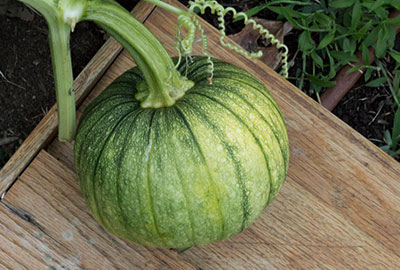
Attentive gardeners may improve their pumpkin harvest by removing blooms and new fruits that appear late in the growing season, and which may not reach maturity before the plant is exhausted. This will help to encourage growth and quality of existing fruits.
Many pumpkin varieties can be picked early and eaten like summer squash but won't be as sweet or flavorful as after full maturity and curing.
To improve uniform appearance of pumpkin fruits, try rotating the fruits every week or two as they grow. Pumpkin fruits are usually more richly pigmented and darker in color where exposed to sunlight. Exposing all sides of the fruits to the sun will help them to develop uniform color. Pumpkin fruits may be damaged by too much direct sunlight. Rotating pumpkin fruits may help to prevent sunscald. An hour or two per day in the sun may be sufficient to bring the fruits to full color. Squash and pumpkin fruits are particularly subject to sunscald late in the season when plants have died back and leaves no longer shade fruits.